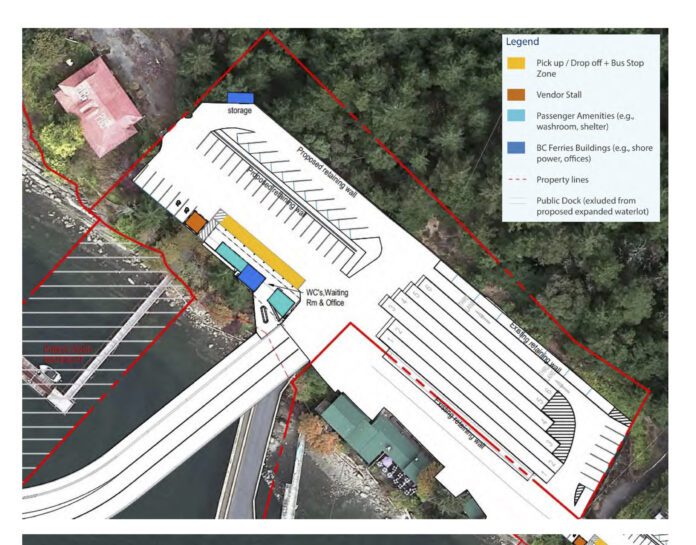BC Ferries is proposing big changes at the Vesuvius Bay terminal — and will need the ongoing approval of Salt Spring’s Local Trust Committee (LTC) to advance much of it.
To kick off the multi-year process, Evan Peterson from BC Ferries’ contractor Barefoot Design came before the LTC Thursday, May 16, bringing a rezoning application that would enable redevelopment of the three parcels that comprise the terminal’s infrastructure.
Those include the vehicle holding area, which BC Ferries leases from the B.C. Transportation Financing Authority; the parking lot, leased from the Ministry of Water, Land and Resource Stewardship; and the marine area, which BC Ferries controls through a licence of occupation from the province.
On land, BC Ferries plans to increase the number of public parking stalls — from 21 to 25 — and retain 16 additional spots for staff. A “thru-lane” is planned for where Lane 7 currently sits, to improve traffic circulation. A designated pick-up and drop-off zone would be built in the existing parking lot near the government wharf, and improved passenger amenities — washrooms, a waiting room and a vendor stall — would be placed alongside the BC Ferries office. Additional holding lanes would increase capacity during busy times, potentially reducing vehicle line-ups onto Vesuvius Bay Road.
For the marine area, BC Ferries will be applying to provincial regulators for a water lot expansion to replace the existing trestle with one that would be long and shallow-sloped enough to allow for vehicle holding — all of which will accommodate the plan for an eventual two-vessel service between Vesuvius and Crofton.
BC Ferries has proposed a phased approach to the project, which means the marine terminal development will start first, with the upland portion once the company allocates the budget for it. Throughout, according to Peterson, islanders can expect ongoing “engagement and communications” about what’s happening and any interruptions or changes to service as a result of the work.
“And then the marine improvements are slated to begin in 2026,” said Peterson. “We’re hoping to have the Island Class ferries for 2027.”
The water lot expansion application is contingent on the LTC approving the rezoning and appurtenant official community plan (OCP) amendment, according to staff. And as it lies within development permit areas, both demolition of the existing trestle and construction of the new one — as well as the parking area upgrades — will require a development permit from the Islands Trust before construction can begin.
Trustees agreed the opportunity to improve both accessibility and traffic at the terminal was worth pursuing. As well, it would bring the existing land use into compliance: despite decades of use for ferry service, the upland terminal and parking area are currently zoned “residential” in the land use bylaw with a “residential neighbourhoods” OCP designation. The LTC directed staff to “notify and seek input” from local First Nations and relevant agencies, and proceed with drafting an amendment bylaw to bring forward at a future meeting.
“This is preliminary; we’re just kicking the process off here,” said Salt Spring trustee Laura Patrick. “I’m glad to see it. I know the terminal is in dire need of some updating.”
The Gulf Island Ferry Company provided ferry service between Vesuvius Bay and Crofton from 1955 until 1961, when BC Ferries started doing so.

